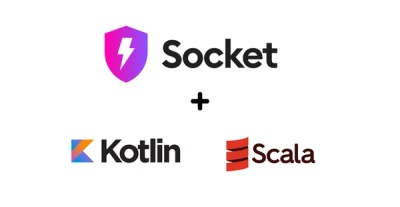
Product
Introducing Scala and Kotlin Support in Socket
Socket now supports Scala and Kotlin, bringing AI-powered threat detection to JVM projects with easy manifest generation and fast, accurate scans.
github.com/deepmind/graph_nets

Graph Nets is DeepMind's library for building graph networks in Tensorflow and Sonnet.
Contact graph-nets@google.com for comments and questions.
A graph network takes a graph as input and returns a graph as output. The input graph has edge- (E ), node- (V ), and global-level (u) attributes. The output graph has the same structure, but updated attributes. Graph networks are part of the broader family of "graph neural networks" (Scarselli et al., 2009).
To learn more about graph networks, see our arXiv paper: Relational inductive biases, deep learning, and graph networks.

The Graph Nets library can be installed from pip.
This installation is compatible with Linux/Mac OS X, and Python 2.7 and 3.4+.
The library will work with both the CPU and GPU version of TensorFlow, but to allow for that it does not list Tensorflow as a requirement, so you need to install Tensorflow separately if you haven't already done so.
To install the Graph Nets library and use it with TensorFlow 1 and Sonnet 1, run:
(CPU)
$ pip install graph_nets "tensorflow>=1.15,<2" "dm-sonnet<2" "tensorflow_probability<0.9"
(GPU)
$ pip install graph_nets "tensorflow_gpu>=1.15,<2" "dm-sonnet<2" "tensorflow_probability<0.9"
To install the Graph Nets library and use it with TensorFlow 2 and Sonnet 2, run:
(CPU)
$ pip install graph_nets "tensorflow>=2.1.0-rc1" "dm-sonnet>=2.0.0b0" tensorflow_probability
(GPU)
$ pip install graph_nets "tensorflow_gpu>=2.1.0-rc1" "dm-sonnet>=2.0.0b0" tensorflow_probability
The latest version of the library requires TensorFlow >=1.15. For compatibility with earlier versions of TensorFlow, please install v1.0.4 of the Graph Nets library.
The following code constructs a simple graph net module and connects it to data.
import graph_nets as gn
import sonnet as snt
# Provide your own functions to generate graph-structured data.
input_graphs = get_graphs()
# Create the graph network.
graph_net_module = gn.modules.GraphNetwork(
edge_model_fn=lambda: snt.nets.MLP([32, 32]),
node_model_fn=lambda: snt.nets.MLP([32, 32]),
global_model_fn=lambda: snt.nets.MLP([32, 32]))
# Pass the input graphs to the graph network, and return the output graphs.
output_graphs = graph_net_module(input_graphs)
The library includes demos which show how to create, manipulate, and train graph networks to reason about graph-structured data, on a shortest path-finding task, a sorting task, and a physical prediction task. Each demo uses the same graph network architecture, which highlights the flexibility of the approach.
To try out the demos without installing anything locally, you can run the demos in your browser (even on your phone) via a cloud Colaboratory backend. Click a demo link below, and follow the instructions in the notebook.
The "shortest path demo" creates random graphs, and trains a graph network to label the nodes and edges on the shortest path between any two nodes. Over a sequence of message-passing steps (as depicted by each step's plot), the model refines its prediction of the shortest path.

The "sort demo" creates lists of random numbers, and trains a graph network to sort the list. After a sequence of message-passing steps, the model makes an accurate prediction of which elements (columns in the figure) come next after each other (rows).

The "physics demo" creates random mass-spring physical systems, and trains a graph network to predict the state of the system on the next timestep. The model's next-step predictions can be fed back in as input to create a rollout of a future trajectory. Each subplot below shows the true and predicted mass-spring system states over 50 steps. This is similar to the model and experiments in Battaglia et al. (2016)'s "interaction networks".

The "graph nets basics demo" is a tutorial containing step by step examples about how to create and manipulate graphs, how to feed them into graph networks and how to build custom graph network modules.
To install the necessary dependencies, run:
$ pip install jupyter matplotlib scipy
To try the demos, run:
$ cd <path-to-graph-nets-library>/demos
$ jupyter notebook
then open a demo through the Jupyter notebook interface.
If you use PyTorch, check out these high-quality open-source libraries for graph neural networks:
pytorch_geometric: See MetaLayer for an analog of our Graph Nets interface.
FAQs
Unknown package
Did you know?

Socket for GitHub automatically highlights issues in each pull request and monitors the health of all your open source dependencies. Discover the contents of your packages and block harmful activity before you install or update your dependencies.

Product
Socket now supports Scala and Kotlin, bringing AI-powered threat detection to JVM projects with easy manifest generation and fast, accurate scans.

Application Security
/Security News
Socket CEO Feross Aboukhadijeh and a16z partner Joel de la Garza discuss vibe coding, AI-driven software development, and how the rise of LLMs, despite their risks, still points toward a more secure and innovative future.

Research
/Security News
Threat actors hijacked Toptal’s GitHub org, publishing npm packages with malicious payloads that steal tokens and attempt to wipe victim systems.